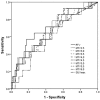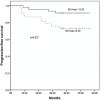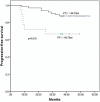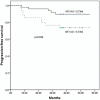Metabolic tumor volume and conformal radiotherapy based on prognostic PET/CT for treatment of nasopharyngeal carcinoma
- PMID: 31305420
- PMCID: PMC6641822
- DOI: 10.1097/MD.0000000000016327
Metabolic tumor volume and conformal radiotherapy based on prognostic PET/CT for treatment of nasopharyngeal carcinoma
Abstract
For patients with nasopharyngeal carcinoma (NPC), prognostic indicators to customize subsequent biologically conformal radiation therapy may be obtained via 2-(fluorine-18)-fluoro-2-deoxy-D-glucose (F-FDG) positron emission tomography/computed tomography (PET/CT). This retrospective study assessed the prognostic significance and feasibility of conformal radiotherapy for NPC, based on F-FDG PET/CT. Eighty-two patients with NPC underwent F-FDG PET/CT prior to intensity-modulated radiation therapy (IMRT). The maximum standardized uptake value (SUVmax) and metabolic tumor volume (MTV) of the primary tumor were measured, with MTVx based on absolute SUVx values ≥ specific threshold x on each axial image. The cut-off SUVmax and MTV values for predicting 3-year progression-free survival (PFS) were calculated according to a receiver operating characteristic curve. Assessed were correlations between SUVmax and MTV and between threshold x and MTVx, and the MTV percentage of the primary tumor volume at threshold x. The SUVmax and MTV were positively associated, as were MTV and primary tumor volume. Primary tumor volume, SUVmax, and MTV were significant predictors of survival. The 3-year PFS rates for SUVmax ≤8.20 and >8.20 were 91.1% and 73.0%, respectively (P = .027). With furthermore analysis, patients having tumor with smaller MTV had higher 3-year PFS than patients having tumor with larger MTV. The 3-year PFS rate was inversely related to MTV. SUVmax and MTV, derived by PET/CT, are important for assessing prognosis and planning radiotherapy for patients with NPC. Small MTV indicated better 3-year PFS compared with large MTV. For the best therapeutic effect, MTV4.0 was the best subvolume to determine radiotherapy boost.
Conflict of interest statement
The authors have no relevant conflicts of interest to disclose.
Figures





Similar articles
-
Correlation of 18 F-FDG PET/CT metabolic parameters with Ki-67 expression and tumor staging in nasopharyngeal carcinoma.Nucl Med Commun. 2025 May 1;46(5):437-443. doi: 10.1097/MNM.0000000000001966. Epub 2025 Feb 19. Nucl Med Commun. 2025. PMID: 39967464
-
Lymph node standardized uptake values at pre-treatment 18F-fluorodeoxyglucose positron emission tomography as a valuable prognostic factor for distant metastasis in nasopharyngeal carcinoma.Br J Radiol. 2017 Mar;90(1071):20160239. doi: 10.1259/bjr.20160239. Epub 2016 Dec 23. Br J Radiol. 2017. PMID: 28008776 Free PMC article.
-
Prognostic value of primary tumor and lymph node volumetric metabolic parameters at pre-treatment F-18 FDG PET/CT in nasopharyngeal carcinoma.Rev Esp Med Nucl Imagen Mol (Engl Ed). 2023 Nov-Dec;42(6):367-373. doi: 10.1016/j.remnie.2023.06.004. Epub 2023 Jun 28. Rev Esp Med Nucl Imagen Mol (Engl Ed). 2023. PMID: 37391092
-
Prognostic value of pretreatment 18F-FDG PET-CT for nasopharyngeal carcinoma patients.Medicine (Baltimore). 2017 Apr;96(17):e6721. doi: 10.1097/MD.0000000000006721. Medicine (Baltimore). 2017. PMID: 28445287 Free PMC article. Review.
-
Prognostic value of maximum standard uptake value, metabolic tumor volume, and total lesion glycolysis of positron emission tomography/computed tomography in patients with nasopharyngeal carcinoma: A systematic review and meta-analysis.Medicine (Baltimore). 2017 Sep;96(37):e8084. doi: 10.1097/MD.0000000000008084. Medicine (Baltimore). 2017. PMID: 28906411 Free PMC article.
Cited by
-
Reflecting on the utility of standardized uptake values on 18F-FDG PET in nasopharyngeal carcinoma.BMC Cancer. 2022 May 5;22(1):495. doi: 10.1186/s12885-022-09626-w. BMC Cancer. 2022. PMID: 35513804 Free PMC article.
-
Research landscape of radiotherapy for nasopharyngeal carcinoma from 1959 to 2022: A bibliometric analysis.Heliyon. 2024 Sep 26;10(19):e38475. doi: 10.1016/j.heliyon.2024.e38475. eCollection 2024 Oct 15. Heliyon. 2024. PMID: 39397984 Free PMC article.
-
Low TLR and PSMA-TV predict biochemical response to abiraterone acetate in metastatic prostate cancer patients developing castration resistance after chemohormonal therapy at hormone-sensitive stage.J Cancer Res Clin Oncol. 2023 Jul;149(8):5071-5084. doi: 10.1007/s00432-022-04438-8. Epub 2022 Nov 4. J Cancer Res Clin Oncol. 2023. PMID: 36333565 Free PMC article.
-
Differences among [18F]FDG PET-derived parameters in lung cancer produced by three software packages.Sci Rep. 2021 Jul 6;11(1):13942. doi: 10.1038/s41598-021-93436-w. Sci Rep. 2021. PMID: 34230642 Free PMC article.
-
Biological target volume based on fluorine-18-fluorode-oxyglucose positron emission tomography/computed tomography imaging: a spurious proposition?Radiat Oncol. 2023 Feb 21;18(1):32. doi: 10.1186/s13014-023-02225-4. Radiat Oncol. 2023. PMID: 36810119 Free PMC article.
References
-
- Torre LA, Bray F, Siegel RL, et al. Global cancer statistics, 2012. CA Cancer J Clin 2015;65:87–108. - PubMed
-
- Chua MLK, Wee JTS, Hui EP, et al. Nasopharyngeal carcinoma. Lancet (London, England) 2016;387:1012–24. - PubMed
-
- Lu H, Peng L, Yuan X, et al. Concurrent chemoradiotherapy in locally advanced nasopharyngeal carcinoma: a treatment paradigm also applicable to patients in Southeast Asia. Cancer Treat Rev 2009;35:345–53. - PubMed
-
- Mu-Kuan C, Tony Hsiu-Hsi C, Jen-Pei L, et al. Better prediction of prognosis for patients with nasopharyngeal carcinoma using primary tumor volume. Cancer 2010;100:2160–6. - PubMed
MeSH terms
Substances
LinkOut - more resources
Full Text Sources

